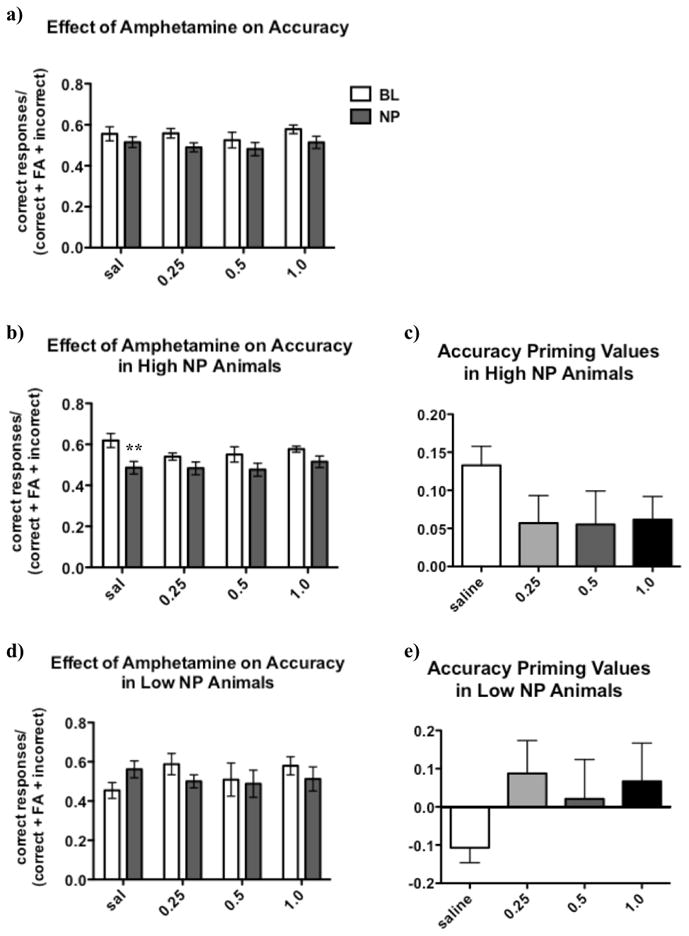Figure 7.

Amphetamine (AMPH) exhibited rate-dependent effects on negative priming (NP). Two-way ANOVA detected a significant effect of Trial Type on accuracy [F(1, 72) = 5.22, p < 0.05]; however, post hoc testing did not reveal any significant differences in accuracy between baseline and NP trials overall at any amphetamine dose (A). No main effects of Amphetamine Dose or Trial Type x Amphetamine Dose interaction were observed overall. However, when animals were examined separately based on their initial NP rate in the drug-free state, significant patterns emerged.
A three-way ANOVA of Median Split Group, Trial Type, and Amphetamine Dose revealed a very strong trend towards a significant interaction [F(3, 33) = 2.90, p = 0.05] between these factors. When accuracy priming values were calculated and compared for the two groups, a significant Median Split Group x Amphetamine Dose interaction [F(3, 33) = 2.98, p < 0.05] was observed. Post hoc testing indicated that groups differed in priming values only after saline administration (p < 0.05), while this difference was lost after AMPH administration at any dose.
In high NP rats, two-way ANOVA revealed a significant effect of Trial Type on accuracy [F(1, 42) = 13.47, p < 0.01]. Post hoc testing revealed that animals exhibited significantly lower accuracy in NP trials compared to baseline trials after saline treatment (p < 0.01). This NP effect was absent after amphetamine administration at any dose (B). Examination of accuracy priming values shows that high NP rats exhibited a robustly positive accuracy priming value after saline treatment that was attenuated by amphetamine treatment at every dose (C), although this effect did not reach statistical significance [F<1.7, ns].
In low NP rats, no significant effect of Trial Type was detected [F<1, ns]. However, a tendency toward lower accuracy in baseline trials compared to NP trials after saline administration was observed. This pattern was reversed after the 0.25 mg/kg dose of amphetamine; here, rats exhibited lower accuracy in NP trials compared to baseline trials, suggesting a strengthened NP effect. Accuracy differences between baseline and NP trials were absent after the higher amphetamine doses (D). While no significant differences in accuracy priming values for low NP were found [F<1.3, ns], inspection of the data suggests that rats did not exhibit an NP effect after saline administration, whereas after administration of the 0.25 mg/kg amphetamine dose, the accuracy difference became positive, indicating a stronger NP effect. At higher amphetamine doses, no NP effect was observed (E).
No main effect of Amphetamine Dose and no interaction were found in either high NP or low NP rats. No significant effect of Trial Type or Amphetamine Dose and no Trial Type x Amphetamine Dose interaction on correct response latency were observed (data not shown).
Data were analyzed using two-way ANOVA, with the two factors Trial Type (baseline or NP) and Amphetamine Dose. Post hoc comparisons of significant effects were conducted using Bonferroni tests. Values are expressed as mean ± SEM. Asterisks (**p < 0.01) denote significant differences compared with baseline trials. BL, baseline; NP, negative priming.
